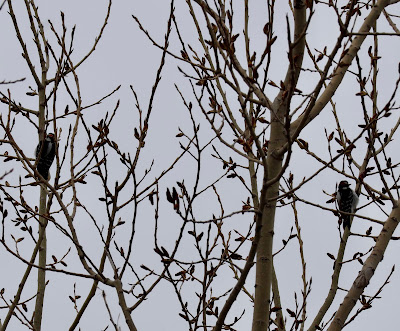For anyone interested: Here are the details of the eBird's May challenge.
Couldn't cut the mustard for April's challenge. I started this month birding on April 1st at Belle Isle in response to the eBird April challenge. (Truthfully, Belle Isle is the only place I've birded this year.) The challenge: chose one place and bird that location twenty times during the month of April and document all sightings. I tried but didn't make it. Twenty times is a lot and many of the days were already occupied by other commitments. As of yesterday my April visits numbered fourteen. I am going to try to get back either today or tomorrow to round out my effort at fifteen visits.
You can review the details of the April challenge in the link. Will link the April eBirder(s) of the month when announced. By contrast May's challenge seems a little easier and many are likely to participate. April weather in my location began with cold, north wind days that persisted through Easter. Nevertheless, with each visit I seemed to find a new bird.
For no particular reason and in no particular order, I chose these photos to document my effort. I did enjoy the challenge and found birds I probably will not see again this year. I also saw birds that I had not seen in many years because I have not paid attention to seeing waterfowl.
Common Loon. No doubt about it, a handsome bird.
Red-breasted Merganser
Red-breasted merg pair and Horned Grebe in the foreground
Terrible photo, but possibly my only chance to see a Fox Sparrow this year.
Another horrible photo. It is only me or do others find Hairy Woodpeckers difficult to find? Here there are a pair. It seems like Hairy Woodpeckers should be easier to find on Belle Isle.
A Bufflehead photo where the bird's eye can be seen!
Blue-winged Teal
Pied-billed Grebe. Super cute little bird.
Bald Eagle landing clumsily on a piece of floating debris.
There is a nesting pair on the island. They are an attractions for the many non-birders who have read about them on social media and visit the island to see them. I have been stopped by many who have asked "do you know where the eagle's nest is?" The nesting Osprey are also gaining some traction with non-birders.
Fishing Osprey
Cooper's Hawk (Astur cooperii)
Doing other reading this morning, I was reminded of Cooper's hawk reclassification to the genus Astur changed from Accipiter in 2024. The change was based on recent genetic research suggesting that the Cooper's Hawk is more closely related to the American Goshawk (now Astur atricapillus) than to other members of the Accipiter genus such as the Sharp-shinned hawk (Accipiter striatus). Incidentally, American was added to the name of goshawk in 2023 to differentiate it as a distinct species from the Eurasian goshawk (Astur gentilis). Prior to this change the goshawk was considered a single species Northern Goshawk (formerly Accipiter gentilis). From: Google's AI summary. There are also plenty of on-line articles to read more detail about this.
To read a more personal account of Eurasian Goshawk read (if you haven't already) Helen McDonald's 2014 book
H is for Hawk which made the NYTs top 100 list for that year. I often use Thriftbooks links for books on this blog, especially older books that can be purchased cheaply on-line. In the case of
H is for Hawk, however, Thriftbook reviewers give it only three stars. It's been a long time since I read it but I would have definitely have given more than three stars.
Caspian Tern
American Kestrel. After seeing almost every visit in Jan, Feb, and March, I saw only once in April. There is a nesting pair on the island.
Black-crowned Night Heron. Seen and photographed many visits.
Field Sparrow
Just removed a crawling wood tick from my neck that came home with me following yesterday's visit. I was hoping that our cold and relatively snowy winter would keep the little bastards' numbers down. Wishful thinking. Now that more and more white-tailed deer are on the island the risk of picking up deer ticks (the Lyme tick) will increase.
Finally, I went to Belle Isle on April 30th to achieve fifteen visits for the month of April.









































